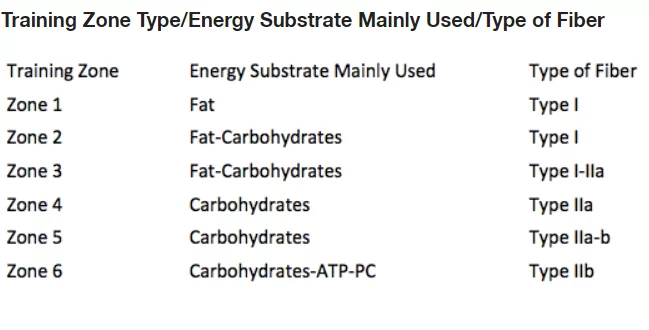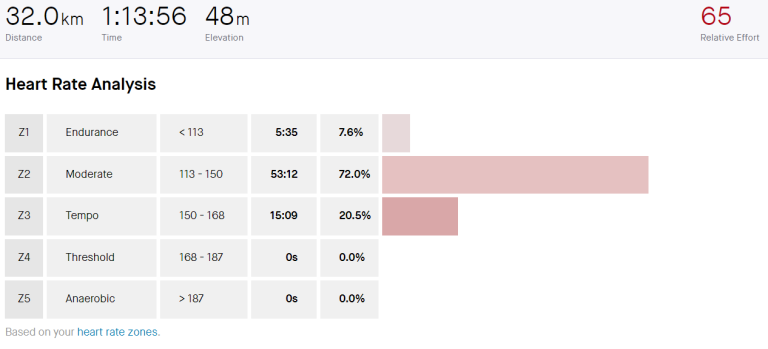Disclaimer: I’m an amateur athlete who started training seriously this year. Please do not take this as expert advice or scientific advice for Zone 2 training. Everything mentioned in this article has been derived from various online articles or videos based on my research. Please do your own research or consult an expert before engaging in any training program.
As mentioned in my 2022 planning , one goal I have for this year is to complete a half marathon, ideally under 2 hours and 15 minutes. Unlike cycling, running was quite new to me, and it was challenging in the beginning. At the time of writing this post, I can easily run a 10K distance and have completed a sub 30-minute 5K run . Even though I enjoy running, I used to feel quite exhausted and tired at the end of my runs. I was looking for ways to train efficiently for long-distance running without overexerting my body and stumbled upon a concept called Zone 2 Training while reading Finding Ultra by Rich Roll .
In a nutshell, Zone 2 training involves training at a low-intensity level for a longer period of time. The goal of Zone 2 training is to sustain an intensity for longer periods such that your heart rate lies in the range of 60-70% of your maximum heart rate. Training at this intensity is incredibly easy, yet boring at the same time. When I started Zone 2 training, I was a bit skeptical as it seemed too easy; I always had the ‘go hard or go home’ attitude when it came to training. Over time, I learned to appreciate the art of slowing down and how it can contribute to my aerobic fitness. In fact, the majority of high-performance endurance athletes follow the Zone 2 training regime, and it has proven benefits according to many scientific studies. The concept can be quite tricky to grasp, as it’s hard to comprehend how training slower can help us go faster. To understand it more, it is necessary to dive into some of the science behind zone training, which I’ve tried to summarize below.
The Science of Zone 2 Training

How an athlete performs depends upon their ability to convert chemical energy into mechanical energy. All cells in our body are fueled by something called Adenosine Triphosphate, or ATP. Mitochondria in our cells generate ATP mainly in two ways—through aerobic or anaerobic mechanisms. The aerobic mechanism involves the conversion of fat into ATP, while in the anaerobic mechanism, carbohydrates are used. Additionally, our muscles contain slow-twitch (Type 1) and fast-twitch (Type 2) fibers. Type 1 muscles have many mitochondria and prefer fat as fuel, whereas Type 2 fibers are glycolytic and prefer carbohydrates. Burning glucose or carbohydrates produces lactate and hydrogen ions, which result in muscle fatigue.

By training in Zone 2, we primarily use Type 1 muscle fibers, utilizing fat deposits as fuel. Lactate build-up is limited in this zone, allowing us to sustain efforts for longer periods. Training in this zone stimulates Type 1 muscle fibers, encouraging mitochondrial growth and improving fat utilization. This allows us to preserve glycogen in our body to use during the final stages of a race when we typically move faster. As mentioned earlier, utilizing Type 2 fibers results in lactate production, but a transporter called MCT-4, present in Type 1 fibers, can transport this lactate to the mitochondria for ATP generation. Thus, Type 1 fibers play a crucial role in lactate clearance as well.
To summarize, training in Zone 2 stimulates Type 1 muscle fibers, which increase mitochondrial density in our muscles. This in turn improves fat utilization and increases lactate clearance, thereby enhancing athletic performance.
How to Train
Ideally, 80% of all training should be done in Zone 2 to improve endurance. The most common and easiest way to train in Zone 2 is by monitoring your heart rate. For this, you’ll need a heart rate monitoring device. I personally use the Amazfit T-Rex Pro , as it’s the only heart rate monitor I have access to. It’s a good and affordable option, and based on my tests, the results are 98% similar to those of the Apple Watch Series 7 . If you have the budget, I would recommend investing in a good heart-rate chest strap or a better watch, like the Garmin Forerunner . Chest straps generally provide more accurate results compared to wrist-based heart rate monitoring in smartwatches.
The first step is determining your maximum heart rate. I personally use the maximum heart rate from the data of all my workouts. You can also engage in an activity like cycling or running, increasing your pace every 2 minutes until you can no longer sustain it. Your heart rate at this point will be your maximum heart rate. Alternatively, you can use the traditional formula by subtracting your age from 220 (for example, if you are 25, your max heart rate would be 195 bpm).
Once you have a maximum heart rate value, your Zone 2 heart rate range will be approximately 70-80% of that number. So if your max heart rate is 195 bpm, your Zone 2 range will be 136-156 bpm. There are various calculators available online to calculate your Zone 2 range. Many recommend the MAF 180 Formula , which you can use to calculate the upper range of your Zone 2.
Training in Zone 2 is simple, yet difficult at the same time. You can run, cycle, or engage in any activity such that your heart rate stays within your Zone 2 range. If you’re running and your heart rate exceeds your upper limit, slow down or start walking to bring it back down. This can be challenging because we all tend to push harder, and running slowly when starting Zone 2 training can feel frustrating. I personally recommend starting with cycling, as it is easier to maintain Zone 2 levels compared to running. If your smartwatch allows, try setting alerts to notify you when your heart rate is out of range. Ideally, 80% of your training should be done in Zone 2.
My Experience So Far

I don’t have any miraculous experiences to share regarding Zone 2 training, as I’ve only been doing it for a few months. I try to do four workouts a week in Zone 2, and I’ve noticed some changes. I feel less fatigue and tiredness post-workouts these days. After a few Zone 2 training sessions, I feel like I can go on forever during my runs. In fact, my first 10K was accidental—I initially planned to do a 5K run while maintaining my heart rate in Zone 2, but after finishing, I felt like I could keep going, so I continued and completed my first 10K. I still struggle to stay in Zone 2, as my heart rate sometimes exceeds the range. When I started, I could only stay in Zone 2 for about 30% of the time, but now I can easily maintain it for 80% of the workout. I’m trying to improve day by day and will update this post when I see more tangible results.
References
- Howard Luks: Zone 2 HR Training
- Training Peaks: Zone 2 Training for Endurance Athletes
- Art of Manliness: Zone 2 Training
📚 Want to stay connected?
If you enjoyed this post, you might like my weekly newsletter 10+1 Things read by 2500+ curious minds from 94 countries. Each week, I share personal insights and 11 fascinating finds — books, articles, or random curiosities that spark ideas.
No pressure, but I'd love to have you along for the ride!
Comments (2)
Hi Rishikesh. Came across this in my search for zone 2 stuff, thanks for the info! Went on my first zone 2 "run" today and found it hard to stay so slow. Any update? How did it work out for you? Cheers, James
It was quite hard at the beginning. I think overtime your body adapts. When I started I had to walk at times because my heart rate was shooting!